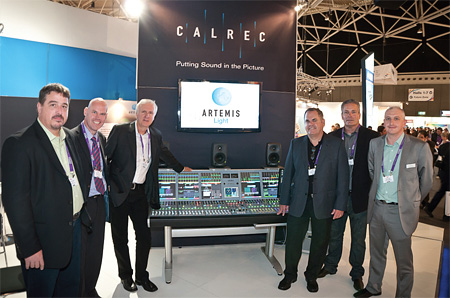Kickstarting Audio for 3D
HOLLWYOOD—At the 2011 NAB Show, film director James Cameron and director of photography Vince Pace revealed that they were joining forces to develop, sell and lease 3D production technology to broadcasters, filmmakers and game producers. More recently, U.K.-based console manufacturer Calrec Audio announced that the new company, Cameron|Pace Group (CPG), is its first customer for the new Artemis Light audio console.

Cameron Pace Group purchases Artemis Light on Calrec’s IBC stand on the day of the product launch. Left to right: Scott Nardelli of Bexel, Calrec’s Henry Goodman, Director James Cameron and Vince Pace, Craig Schiller of Bexel, and Calrec’s Dave Letson. The new Artemis Light system has been purchased as part of an upgrade to CPG's Mobile Unit 1 remote production vehicle. Artemis Light—the newest member of Calrec's Artemis family of Bluefin2 Hydra2 audio consoles that is centered on a compact processing rack dedicated to delivering DSP and routing functionality in a 4RU enclosure—will bring surround sound production capabilities to the mobile unit.
EXTENSIBLE PLATFORM
Key to the purchase decision was Calrec's reputation and broad base of operators plus the compact yet extensible nature of the Artemis Light platform. "Calrec has a lot of supporters out there, a lot of people who like that they can go to multiple consoles, sit down and feel at home," explained Pace.
Installing a product with industry-wide acceptance is important to CPG, because, he said, "We weren't born as a mobile production unit company. We've been servicing the needs of 3D for about five years in the mobile unit sector but it's not our nature."
But while Pace talks of past experience with 3D, going forward, the business model is 5D. The company's patented Shadow D technology allows the 2D and 3D cameras to be co-located, a critical factor in driving down production costs and in delivering the same experience that consumers have come to expect in 2D in 3D.
There's really no reason to reinvent the wheel in order to produce quality 3D, Pace believes, and that also applies to audio. "Whether you're talking about production techniques, whether you're talking about lensing and cameras and audio, the success of 3D will be on the backbone of successful 2D. If someone is crafting the right sound package for a 2D show it's the ideal package for the 3D show, because good sound is good sound."
Introducing some emerging new technology that is not yet ready for primetime or a different approach risks alienating consumers, Pace emphasized. "I don't think the consumer is ready for us taking away from the 2D experience to give them 3D. What they're expecting is, whether we shoot 2D or 3D, give me great sound, because that's what I'm used to."
SHARING ASSETS
For those productions that require more assets than the Artemis Light delivers, the platform's scalability will allow CPG to rent additional Calrec I/O capability and expand the Hydra2 network according to a project's needs. John Root, business development manager for Bexel, Calrec's West Coast distributor, was reportedly instrumental in the sale by offering assurances that such equipment would be made available promptly when required.
"The Artemis Light for me is the great 5D companion moving forward," Pace explained. "Once [Calrec] started describing the platform, how they're going about the industry and creating this infrastructure of sharing assets through their system, it was a perfect choice. We can lean on other assets already in play through their infrastructure, and we can expand through their Bexel relationship with a rental model that helps us to grow based on customer demands."
CPG already has its sights set on its next mobile unit: "The interest on our end is to build a 5D truck that would have the big brother to this platform, and the ability to share the infrastructure for us is one of the most desirable parts of the sales pitch," Pace said.
But never mind the equipment—what will determine CPG's success will be determined by how attractive the company can make the business model to the industry, as Pace elaborated. "Does the revenue compensate for the incremental cost? Can we get the incremental cost closer to the 2D model, which is well understood? That's all we do for a living at CPG, is try to innovate the business model, because we already know the end result is compelling."
CPG is focused on the broadcast market, he continued. "We honestly believe that if we can lick the broadcast model and the television model, everything else will be backfill. When done correctly, there will be no excuse not to service both the 2D and the 3D market from a single production."
Barriers to more widespread adoption of 3D production are also falling at the consumer end, he further noted, with the increasing availability of 4K displays supporting 2K resolution 3D as well as glasses-free operation. "It looks better, the resolution is there, the glasses have gone away, and in three years, if CPG is successful, everybody will sit back and say, why haven't we been doing this all the time?"
Get the TV Tech Newsletter
The professional video industry's #1 source for news, trends and product and tech information. Sign up below.
Steve Harvey began writing for Pro Sound News and Surround Professional in 2000 and is currently senior content producer for Mix and a contributor to TV Tech. He has worked in the pro audio industry—as a touring musician, in live production, installed sound, and equipment sales and marketing—since November 1980.
